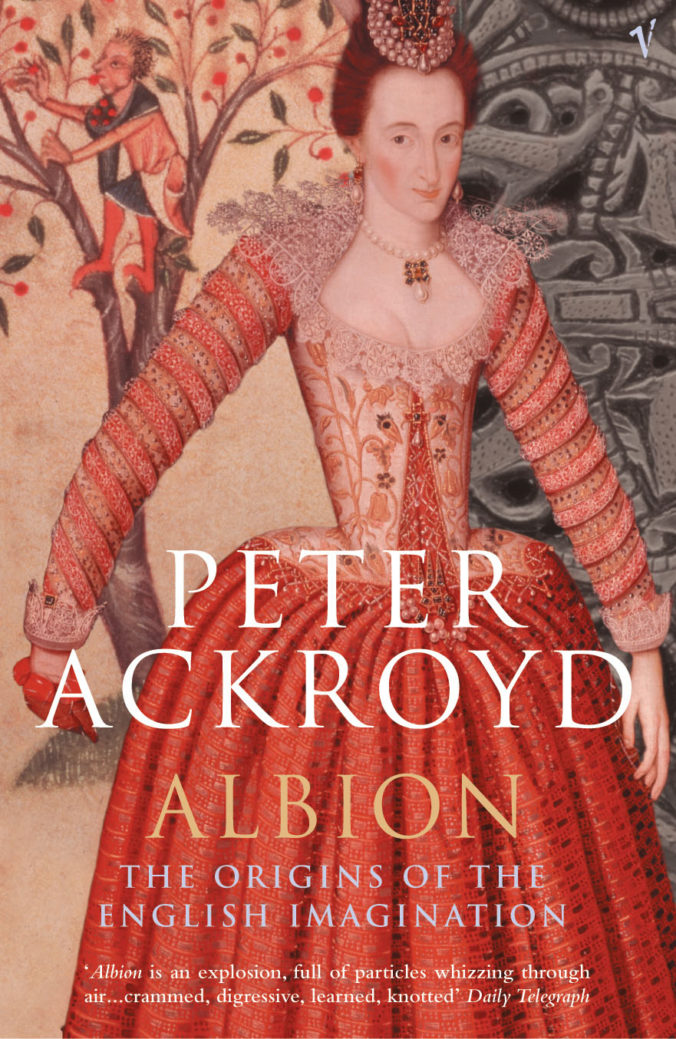(Published in The Salisbury Review, Spring 2003)
Peter Ackroyd has produced a long study of great ambition, which in 53 short chapters explores the sources of the English imagination. It seems clear that Ackroyd has set himself two main tasks. The first is to trace the origins of the imagination in Anglo-Saxon texts, early myths, historical documents and religious imagery. The second is to show how certain central themes that Ackroyd has identified recur over the centuries, for example: the myth of King Arthur; the use of dreams and visions in literature; the strain of melancholy in the English imagination; the love of gardens; the need for a connection to landscape; the central motif of ‘character’ in English fiction. Throughout the book, Ackroyd maintains a deep belief in the imagination’s role as the storehouse for the ‘origins’ of the collective consciousness of a nation.
The introduction is titled ‘Albion’ (the ancient name for England) and the first sentence claims: ‘Of the English imagination there is no certain description.’ Ackroyd gives us a feast of material in these densely packed chapters that investigate this point, but no clear guidelines about how to judge what are the most important elements of the English imagination. However, in chapter 5 the author makes two points about the seventh century historian Bede, which suggest clearly the approach Ackroyd has taken to his own work: ‘Bede lent English history the coherence and consistency of art’ and ‘history is an art, in other words, and cannot be finally distinguished from drama or from fiction.’ Ackroyd implicitly favours as a method the use of the historical imagination, of the ability of the individual to feel, know and reconstitute the past. But his approach to history is paradoxical. For he often treats the concept of the imagination as if it were timeless, embodying transcendent truths, to which the properly-tuned individual may connect: ‘our ancestors shine through at that moment of quietus and we are but a palimpsest of past times.’ This attitude seems to link strongly to an idea expressed by T.S. Eliot in his essay ‘Tradition and the Individual Talent’ (1919). T.S. Eliot wrote: ‘The historical sense, which is a sense of the timeless as well as of the temporal and of the timeless and of the termporal together’ (Ackroyd’s brilliant biography of T.S. Eliot was published in 1985).
Ackroyd’s technique is illustrated in the first chapter, ‘The Tree.’ The author draws together various forms of evidence, religious, symbolic, mythic, literary, that have collected in the English imagination around the idea of the tree. For example, the spiritual importance of the tree to the Druids, the mythic resonance of the forest in the legend of Robin Hood, the magical quality of trees in Kipling’s Puck of Pooks Hill, the symbolic relevance of trees in Jane Eyre and Women in Love, and much else, all in five pages. Ackroyd concludes the chapter, ‘So the tree grows through the literature of the English.’ The connections he makes, ricocheting across genres, places and times, are electric. It is as if the origins of the imagination, in this case ‘the tree’, form a special category, ‘of the timeless and the temporal together’ in Eliot’s phrase. This category may then be detached from a particular place or story, to form a simultaneous and timeless source of inspiration, which may be drawn upon at any time by reader or writer.
Ackroyd consistently makes revealing connections in these chapters. However, because each chapter feels like a fresh endeavour, there is a lack of an underlying argument to Ackroyd’s project. The reader does not always know where we are being led, or why.
As the book proceeds it becomes clear that this is less an objective study of the origins of the English imagination than Ackroyd’s own subjective interpretation, guided by his longing for a lost Catholic tradition: ‘the Catholic culture of fifteen hundred years ago could not wholly die. Its inheritance is buried just below the surface of our own times.’ He also points out that ‘John Milton’s family were Catholic’, and of Shakespeare ‘that the evidence suggests that his father was a Roman Catholic.’ This study leans towards a Catholic interpretation of the origins of the imagination, in the sense of a quasi-mystical connectedness between all phenomena, which thus transcends historical time. But there is far too little close analysis of a great Protestant work, Bunyan’s The Pilgrim’s Progressfor instance, to illustrate differences from, and similarities to, a Catholic interpretation of the imagination. Nor, as a subsidiary point, does Ackroyd deal with the issue of social class and the English Imagination: what origins are shared between, say, a Leveller and an upper-class Anglo-Catholic?
The Catholic perspective does not lessen the reader’s pleasure, but two particular absences from this study may do. First, there is very little discussion of how the political perspective of writers shapes their sense of what they consider the origins of the English imagination to be. For instance, Evelyn Waugh (I am thinking especially of Brideshead Revisited) would surely have had a radically different taxonomy of the English imagination than George Orwell. Perhaps both authors do have in common some shared concepts of the imagination, but the absence of any discussion on this point disappoints. Second, Darwin’sThe Origin of Species is dismissed summarily as ‘essentially a work of fiction.’ This is nonsense. When this minutely-researched scientific study was published in 1859 it reshaped, or even uprooted, Victorian culture’s sense of its own origins. According to Darwinian interpretation, mankind was no longer a unique species that began with Adam and Eve. Instead the human species was part of a vast temporal flow, which predated Christianity by millions of years, and made mankind brother to the monkey. In turn, the English imagination, in Hardy’s The Return of the Native (1878) for example, showed the importance of Darwin’s ideas in shaping a different idea of the relationship between landscape and man. Hardy’s characters are diminished by a temporal order that views humanity as transitory and inconsequential. Hardy explored how the long history of geology marginalized human history, and forced the imagination to engage differently with its beginnings. And perhaps each generation reinterprets the origins of its nation’s imagination. Ackroyd does not discuss these points.
Albion: The Origins of the English Imagination is a beautifully presented, delightfully illustrated book. In the otherwise full bibliography there is one unfortunate omission. There is no mention of David Gervais’s superb book, Literary Englands: Versions of ‘Englishness’ in Modern Writing (1993), which deals in a more scholarly manner with a number of themes that are considered by Ackroyd.
Albion is a study that is best read and savoured in small portions. In this way the concentrated illuminations are fully appreciated, and the reader is able to engage, empathize and argue with the author, without being irritated by the lack of a cohesive argument. Ackroyd has written a work as quirky and wilful, fresh and vivid as the English imagination itself.

